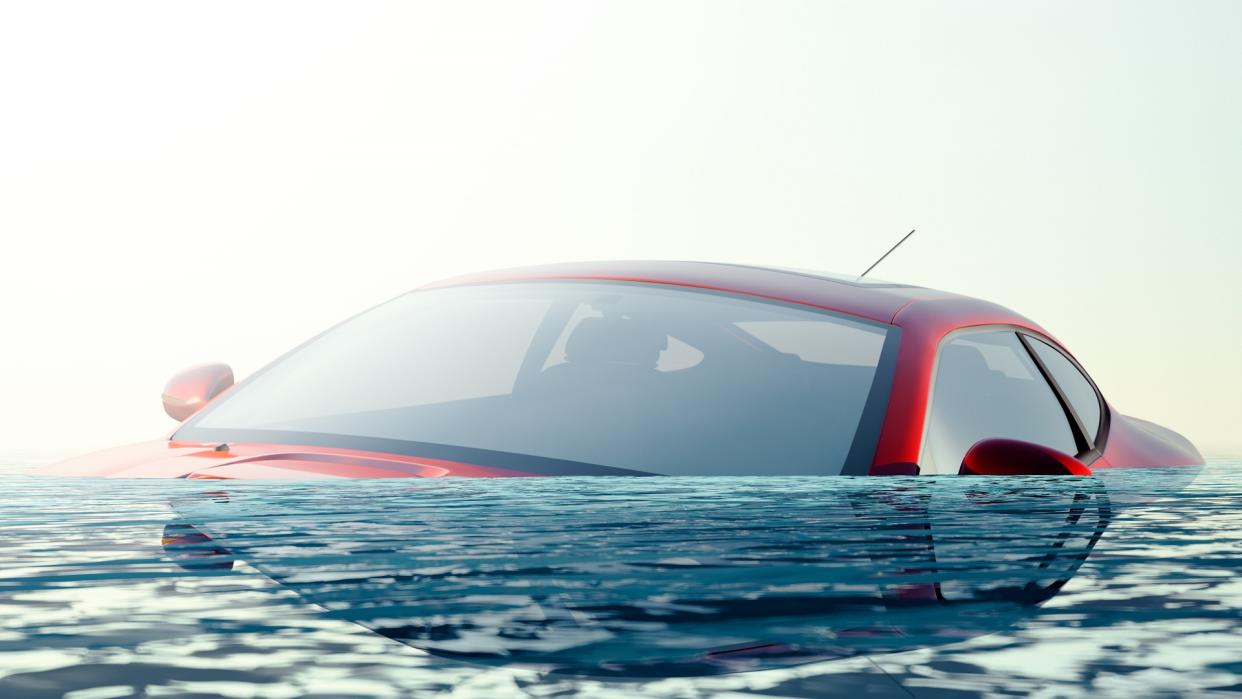Hurricane Aftermath: How To Avoid Buying a Car That Was Damaged In a Flood

Hurricane and flood activity in the U.S. has followed an irregular course in 2022. Rather than picking on specific localities, overflowing water has bullied large sections of the country, impacting lives and livestock and damaging property, crops, communication, infrastructure and more.
More for Your Money: The Most (and Least) Reliable Cars of 2023 Ranked
Explore: If Your Credit Score Is Under 740, Make These 4 Moves Now
Less reported in the aftermath of devastating flooding is the loss of a vehicle to an individual or family. A house is typically the biggest purchase anyone might make, but the second largest is most often an automobile. Their costs are considerable and they need extensive maintenance for years.
Flood wrecked cars are a burden for their owners (and especially for risktakers that don’t have insurance), but a boon for corrupt sellers who repair and resell water-logged cars in other parts of the country from where they were originally drowned. According to Carfax, 378,000 flooded vehicles managed to get back on the roads in 2021.
Fortune stated that 2017’s two Category 4 hurricanes, Irma and Harvey, ruined an estimated one million cars. As the Insurance Information Institute (III) claimed in 2006, the previous year’s Hurricane Katrina flood damaged 500,000 vehicles, “many of these vehicles have been purchased by dishonest auto dealers, cleaned up and then sold, with their flood damage history illegally hidden.”
Damaged vehicles are often moved out of state and “washed” of flood evidence and history, making flood ravaged cars hard to identify. And because water can take months or years to corrode electronics and mechanical systems, precise inspections are essential.
Take Our Poll: How Has Inflation Impacted Your Holiday Shopping Plans?
“Even if a vehicle looks acceptable and may be working when you inspect it,” deep-water exposure red flags should be avoided, said Consumer Reports’ chief mechanic John Ibbotson.
According to How Stuff Works, used car buyers worried about buying a flood-damaged car should insist on written “all-clear” statement from a dealer or seller. They should also be wary of an exceedingly generous price, well below market value, and a resistance to include a warranty if the car is being sold by a dealer.
You should also insist on looking at the vehicle’s title, “a legal document that proves who owns a vehicle and provides details about the vehicle’s history,” per Autolist. But not all titles reflect flood damage. Rebuilt cars and cars without insurance often won’t have official records of flood damage.
Luckily, there are free services for consumers to check whether a used vehicle they are considering buying has been reported to have been impaired by water. Searching the vehicle identification number (VIN) databases at the National Insurance Crime Bureau (NICB), Carfax and Experian’s AutoCheck can provide vehicle histories and help you avoid buying a flood-damaged car.
See: 40 Cheap Upgrades That Will Make Your Car Feel Like a Luxury Vehicle
Find: 5 Questions To Ask Before Buying an Electric Vehicle
Finally, if it doesn’t pass your smell and sight tests, or if a deal seems too good to be true, you may be looking at a used flooded lemon. Taking a test drive and getting an inspection done by a reputable garage mechanic are fundamental, but Carfax lists seven tell-tale sign of water damage that prospective buyers can look for when in doubt.
A musty odor in the interior, which sellers sometimes try to cover with a strong air-freshener
Upholstery or carpeting that may be loose, new, stained or doesn’t seem to match the rest of the interior
Damp carpets
Rust around doors, under the dashboard, on the pedals or inside the hood and trunk latches
Mud or silt in the glove compartment or under the seats
Brittle wires under the dashboard
Fog or moisture beads in the interior lights, exterior lights or instrument panel
More From GOBankingRates
Zelle Scams on Facebook Marketplace: How To Recognize and Avoid Them
5 Best Southern Cities To Retire on a Budget of $1,500 a Month
This article originally appeared on GOBankingRates.com: Hurricane Aftermath: How To Avoid Buying a Car That Was Damaged In a Flood
